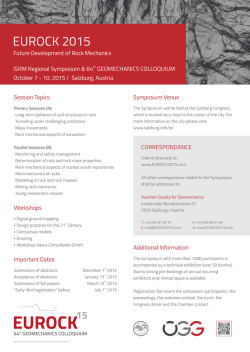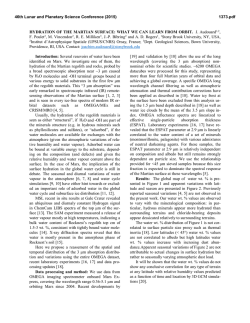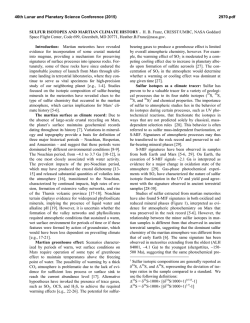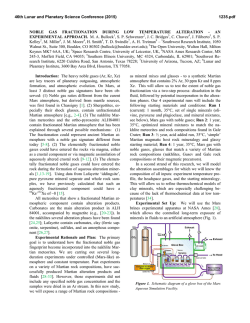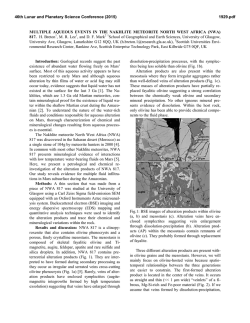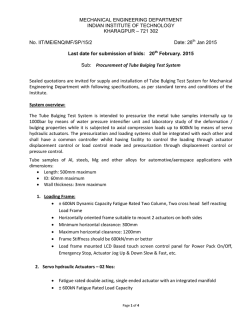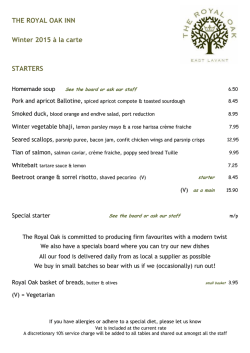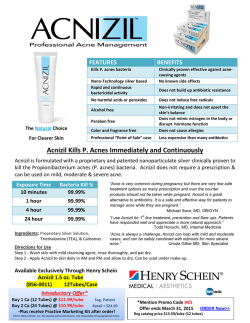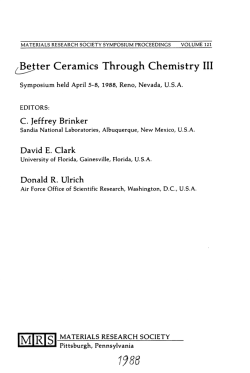
SIMULATING A MARTIAN FUMAROLE: UNDERSTANDING THE
46th Lunar and Planetary Science Conference (2015) 2305.pdf SIMULATING A MARTIAN FUMAROLE: UNDERSTANDING THE EFFECTS OF A DEGASSING MARTIAN MAGMA ON SURROUNDING ROCK. N. J. DiFrancesco,1 H. Nekvasil,1 S. J. Jaret,1 D. H. Lindsley,1 and A. D. Rogers.1 1Stony Brook University, Dept. of Geosciences, Earth and Space Science Building, Stony Brook, NY 11794. [email protected]. Introduction: The Martian crust has been studied extensively through measurements from orbit and the surface, indicating that most of the crust is composed of mafic igneous rock[1]. Much of the surface also shows some extent of low temperature alteration. While most of this alteration can be explained by aqueous processes[2,3], there has been abundant orbital evidence for local hydrothermal metamorphism operating in some areas [4,5]. It has also been demonstrated that impacts into Mars’ surface could release sufficient energy to produce long-lived hydrothermal systems in and around craters[6,7]. MER rover Spirit encountered likely hydrothermal terrain at Home Plate, in Gusev Crater, with elevated levels of halogens, sulfur, and other volatile elements [8,9]. While it seems apparent that some form of hydrothermal alteration has taken place on the Martian surface, constraining the specific process remains difficult[9]. Phyllosilicates, unequivocal products of alteration, are generally produced in water-rich environments; however, much of the chemical alteration that has taken place on Mars throughout its most recent history has likely occurred at very low water-rock ratios[10] and in local environments where magmatic gases may have played an important role, such as in fumarolic systems. Understanding the mineralogy and chemistry of such systems is crucial for identifying other similar locales on the Martian surface. Furthermore, being able to recognize signatures of potential fumaroles from orbital observations could prove valuable when searching for prospective landing sites for future survey or sample return missions. These areas of magmatic activity would also be prime areas to continue to search for evidence of past or present life on the Martian surface[11]. To understand this process on Mars, we have initiated the design and implementation of a simulated fumarole. Experimental design: There are many considerations that go into designing an experiment that can accurately mimic a fumarolic environment on the Martian surface. There must be a source material or “magma” that generates a vapor phase. There also must be a country rock (the “target rock”) representing the material that is being altered. The source rock must be at higher temperature than the target. An oxygen fugacity consistent with the Martian surface must be maintained, and all should be isolated as much as possible from the terrestrial environment. Ideally, the source magma for the vapor phase should have a composition that is similar to rock found on Mars. The MER rovers analyzed several finegrained igneous rocks that may well have risen close to the surface while mostly, if not entirely liquid[12]. The rock Irvine is an example of one such basalt and chosen here as a source rock. Using this composition as a starting point, we are able to produce vaporsaturated “magmas” capable of releasing volatile gases. A target “rock” with plagioclase, pyroxene, olivine and glass can be synthesized using the same Irvine composition, but allowing it to partially crystallize. This is an approximate representation of an “average” Martian crust. We sought varied target rocks in order to better understand the effect of protolith composition on alteration products, so we will use synthesized Irvine glass as target rock because it should be more readily altered. Natural minerals such as albite, augite, and olivine were also used in this preliminary study. Experimental details: We have synthesized two “source magma” mixtures of Irvine composition using oxide and silicate powders. One anhydrous mix contained halogens, added as MgCl2 and MgF2. A second hydrous mixture, but free of halogens contained water, added in the form of brucite (Mg[OH] 2). Powders were separately loaded into individual graphite-lined platinum capsules, each pressurized to 1 GPa in a piston cylinder press, melted at 1400ºC, then quenched to a glass. Equal parts of each glass were weighed and crushed together with added Zinc and Rubidium (as ZnO and RbN2). Separate mixes were employed in order to maximize the dissolved volatiles in each melt; chemical analyses are in Table 1. Note the low totals for the hydrous liquid, this is likely due to an added 4.65% water; however detailed FTIR to quantify dissolved water has not been completed yet. For the alteration experiments, this glass was loaded into a Au80Pd20 capsule that was lightly crimped at the top to allow gases to escape. This capsule is placed inside the silica glass tube, on top of a small spacer (Fig. 1). SiO2 Halogen Liquid Hydrous Liquid Irvine Bulk TiO2 Al2O3 FeO MnO MgO CaO Na2O K2O P2O5 Cr2O3 SO2 Cl Total 49 1.02 11.04 17.57 0.32 8.55 5.43 1.95 0.57 1.03 0.77 2.58 100 45.33 1.00 10.16 18.34 0.36 10.03 5.38 2.38 0.53 0.81 - - - 94.3 47 1.06 8.29 19 0.36 10.6 6.03 2.68 0.68 0.97 0.2 2.37 0.45 99.7 0.16 Table 1- EMPA of synthesized target and source materials. All numbers in wt. %. Irvine bulk composition taken from [13]. The oxygen fugacity chosen for the experiments is FMQ. To achieve this, a mixture of magnetite and 46th Lunar and Planetary Science Conference (2015) quartz was prepared and loaded into a separate Au80Pd20 capsule that was lightly crimped closed, but otherwise open to the atmosphere; this was placed inside the tube next to the source material. This serves to buffer our experiments at or near FMQ. The target rock for vapors to interact with and alter, is synthesized in a similar manner to the source rock. After synthesis of rock, solid chunks of sample (approximately 4-8mm long) are wrapped in a “nest” of W95Re5 (type W) thermocouple wire, that is sitting in a constriction made in the silica tube (Fig. 1). This setup allowed for maximum vapor flow around the target, while preventing the target material from coming into contact with the silica glass walls of the tubes they are contained in. Thermocouple wire was used because it is resistant to the heat, and thought to be relatively unreactive. Other experiments will employ a finely crushed target rock contained in Au80Pd20 capsules that have been perforated with holes and left open to the vapors inside the silica glass. This will help to maximize surface area and therefore increase chances for formation of secondary minerals. Figure 1- Diagram of the silica glass tube suspended inside of a vertical furnace for vapor-alteration experiments. Entire tube is approximately 25cm long. The silica tube assembly is evacuated and sealed shut, with a small hook at the top, as shown in Figure 1. The tube is suspended inside of a vertical Pt-wound furnace; the temperature gradient of the furnace has been carefully calibrated with a “dummy” tube in place, so that the temperature of the source and target 2305.pdf is well known. The sample and buffer are placed in the hottest part of the tube (~1200ºC), thereby, permitting the sample to melt and boil off dissolved gasses. These gases then rise upwards towards the cooler sample (< 400ºC), where they can interact with, and alter the minerals present. These temperatures were chosen as they are within the range for terrestrial fumarolic systems [14]. Results: Proof-of-concept experiments were conducted using olivine crystals as the target material. The preliminary results show that for experiments lasting for 8-12 hours, we are able to maintain the integrity of the silica tube. XRD analysis of the buffer following recovery of the sample demonstrated that the three minerals remain in the buffering assembly. This also appeared to be of sufficient time to cause alteration of the target sample, as well as deposition of sublimates inside of the silica tube. Reaction of the olivine was evident when comparing the reacted target with a control target that was exposed to these temperatures at vacuum. The reacted target olivine was visibly discolored, and coated in a fine yellow/orange powder that also appeared to coat the inside of the silica glass tube above (and at a lower temperature than) the sample. Condensed fluid was also apparent inside the tube. Preliminary analyses have demonstrated the transport of Cl, Fe, Zn, and Au (presumably from the capsule) from the source to the target and upper walls of the tube. Quantitative ICPMS analyses of the vapor deposits/sublimates on the inner walls of the silica glass will be forthcoming. The target samples will be analyzed by SEM, XRD, and Raman spectroscopy to identify any newly produced mineral species. Visible near infrared (VNIR) and thermal infrared (TIR) spectroscopy will also be conducted to try and identify an “alteration fingerprint” for hydrothermal systems at the surface. Acknowledgements: This work is supported by NNH12ZDA001N-MFRP to H. Nekvasil and A. D. Rogers. References: [1]Hamilton V.E. et al (2003) MaPS 38. 6. pp 871-885. [2] Haskin, L.A. et al. (2005) Nature 436 pp 66-69. [3] Poulet, F. et al. (2005) Nature 438 pp 623-627. [4] McSween, H.Y., et al. (2014) MaPS. [5] Ehlmann, B.L. et al. (2010) GRL. 37, 6. [6] Newsom, H.E. (1980) Icarus. 44 pp 207-216. [7] Schwenzer, S.P. & Kring, D.A. (2013) Icarus. 226 pp 487-496. [8] Schmidt, M.E. (2008) JGR:Planets 113, E6. [9] Ruff, S.W. et al. (2011) JGR:Planets 116, E7. [10] Hurowitz, J.A. & McLennan, S.M. (2007) EPSL 260. pp 432-443. [11]Shock, E.L. (1997) JGR 102, E10. [12] McSween, H.Y. et al. (2006) JGR:Planets 111, E9. [13] McSween, H.Y. et al. (2008) JGR:Planets 113, E6. [14] Connor, C.B. et al. (1993) JGR 98, B11
© Copyright 2025

